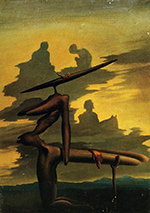
"The Enduring Chill"
"What's wrong with me is way beyond you" (557).
Flannery O'Connor's "The Enduring Chill" (1958; 1965)
Points
for Reflection
Flannery O'Connor's "The Enduring Chill" (1958; 1965), 547-72
- what lesson does Asbury think his mother needs to learn, and why is he the best one to teach it to her?
- does Asbury want to die? Why, or why not?
- why does Asbury’s mother happily envision him writing novels, plays, and poems at home (555)? Does she value artistic production as a useful intellectual and creative exercise?
- is Asbury right to blame his mother for his artistic impotence (554)?
- what might O’Connor intend the bird-like water stain on his bedroom ceiling to symbolize?
- do any of the characters blanketed by Asbury’s disdain appear to deserve such rough treatment?
- Asbury considers himself to exist “in a state of illumination” as his death approaches (557). Does he indeed see reality more clearly in these final days?
- why does Mrs. Asbury proscribe the consumption of milk right out of the milking machine?
- is Randall correct, that Asbury’s problem is a lack of correction from his mother when he was young (560)? Does her current treatment of Asbury provide support for Randall’s observation, one way or the other?
- why does Asbury ask for a priest to visit him in his last days, and does the priest fit the bill?
- why does Asbury have his mother remove most of the furniture prior to the priest’s visit?
- is the priest correct in his description of Asbury as “‘a good lad at heart but very ignorant’” (567)?
- what kind of “communion” did Asbury achieve while smoking with the two dairy workers (558), and does he successfully recreate it on his deathbed (568)?
- what is the “purifying terror” that Asbury fears being confronted with for the rest of his days (572)?
- what is the “last film of illusion” torn from Asbury’s eyes at the conclusion (572)?

The Spectre of the Angelus (1934)
Salvador Dalí
Dr. Paul Marchbanks
pmarchba@calpoly.edu
![]()
